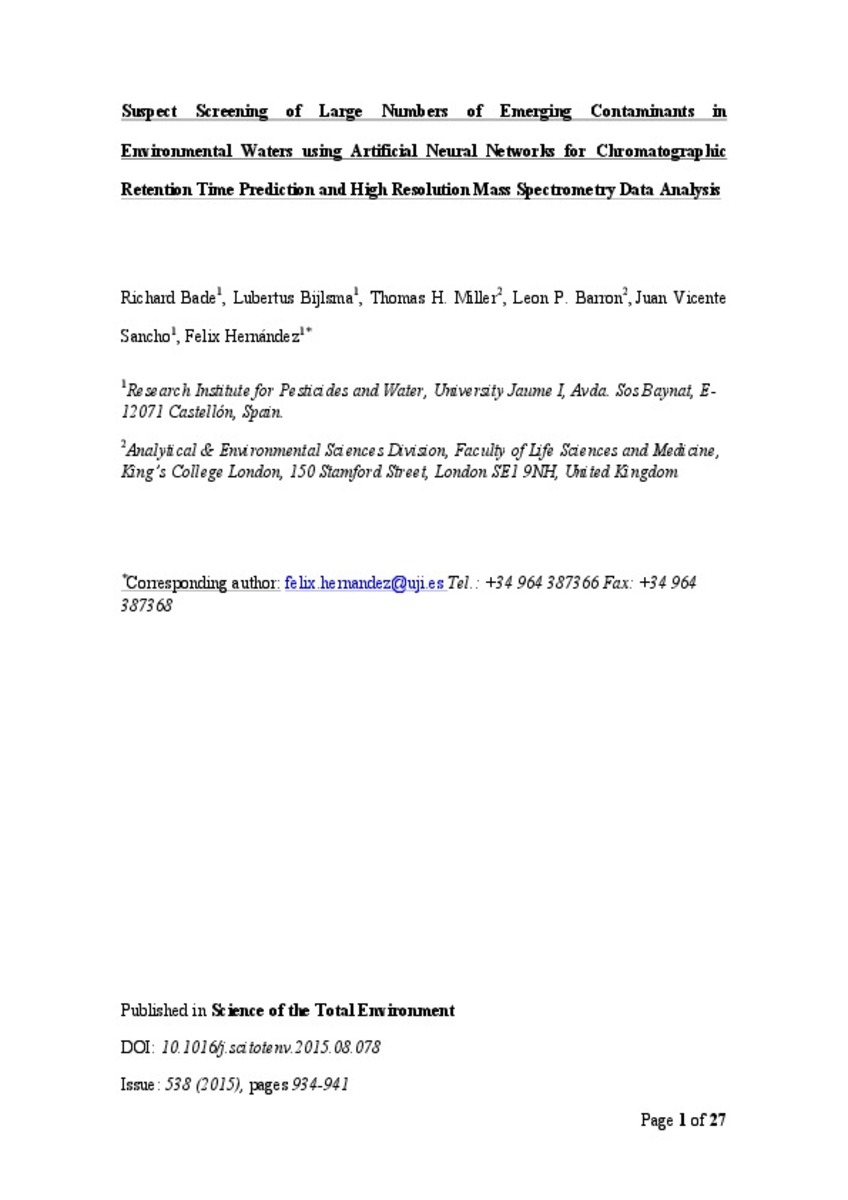Mostrar el registro sencillo del ítem
Suspect Screening of Large Numbers of Emerging Contaminants in Environmental Waters using Artificial Neural Networks for Chromatographic Retention Time Prediction and High Resolution Mass Spectrometry Data Analysis
| dc.contributor.author | Bade, Richard | |
| dc.contributor.author | Bijlsma, Lubertus | |
| dc.contributor.author | Miller, Thomas H. | |
| dc.contributor.author | Barron, León P. | |
| dc.contributor.author | Sancho, Juan V | |
| dc.contributor.author | Hernandez, Felix | |
| dc.date.accessioned | 2015-12-02T12:15:39Z | |
| dc.date.available | 2015-12-02T12:15:39Z | |
| dc.date.issued | 2015-12-02 | |
| dc.identifier.issn | 1879-1026 | |
| dc.identifier.issn | 0048-9697 | |
| dc.identifier.uri | http://hdl.handle.net/10234/142288 | |
| dc.description.abstract | The recent development of broad-scope high resolution mass spectrometry (HRMS) screening methods has resulted in a much improved capability for new compound identification in environmental samples. However, positive identifications at the ng/L concentration level rely on analytical reference standards for chromatographic retention time (t(R)) and mass spectral comparisons. Chromatographic t(R) prediction can play a role in increasing confidence in suspect screening efforts for new compounds in the environment, especially when standards are not available, but reliable methods are lacking. The current work focuses on the development of artificial neural networks (ANNs) for t(R) prediction in gradient reversed-phase liquid chromatography and applied along with HRMS data to suspect screening of wastewater and environmental surface water samples. Based on a compound t(R) dataset of >500 compounds, an optimized 4-layer back-propagation multi-layer perceptron model enabled predictions for 85% of all compounds to within 2 min of their measured t(R) for training (n = 344) and verification (n = 100) datasets. To evaluate the ANN ability for generalization to new data, the model was further tested using 100 randomly selected compounds and revealed 95% prediction accuracy within the 2-minute elution interval. Given the increasing concern on the presence of drug metabolites and other transformation products (TPs) in the aquatic environment, the model was applied along with HRMS data for preliminary identification of pharmaceutically-related compounds in real samples. Examples of compounds where reference standards were subsequently acquired and later confirmed are also presented. To our knowledge, this work presents for the first time, the successful application of an accurate retention time predictor and HEMS data-mining using the largest number of compounds to preliminarily identify new or emerging contaminants in wastewater and surface waters | ca_CA |
| dc.description.sponsorShip | EU-International Training Network SEWPROF (Marie Curie - PEOPLE Grant): 317205 ; Spanish Ministry of Economy and Competitiveness: CTQ2012-36189 ; Generalitat Valenciana: research group of excellence PROMETEO II/2014/023 ISIC 2012/016; Biotechnology and Biological Sciences Research Council (BBSRC) ; AstraZeneca (under the Global SHE research program): BB/K501177/1 | ca_CA |
| dc.format.mimetype | application/pdf | ca_CA |
| dc.language.iso | eng | ca_CA |
| dc.relation.isPartOf | Science of the Total Environment, vol. 531 (2015) | ca_CA |
| dc.rights | 2015 Elsevier B.V. All rights reserved. | ca_CA |
| dc.rights.uri | http://rightsstatements.org/vocab/InC/1.0/ | * |
| dc.subject | retention time prediction | ca_CA |
| dc.subject | artificial neural networks | ca_CA |
| dc.subject | time-of-flight high resolution mass spectrometry | ca_CA |
| dc.subject | screening of emerging contaminants | ca_CA |
| dc.title | Suspect Screening of Large Numbers of Emerging Contaminants in Environmental Waters using Artificial Neural Networks for Chromatographic Retention Time Prediction and High Resolution Mass Spectrometry Data Analysis | ca_CA |
| dc.type | info:eu-repo/semantics/article | ca_CA |
| dc.identifier.doi | http://dx.doi.org/10.1016/j.scitotenv.2015.08.078 | |
| dc.rights.accessRights | info:eu-repo/semantics/openAccess | ca_CA |
| dc.relation.publisherVersion | http://dx.doi.org/10.1016/j.scitotenv.2015.08.078 | ca_CA |
| dc.edition | postprint | ca_CA |
| dc.type.version | info:eu-repo/semantics/acceptedVersion |
Ficheros en el ítem
Este ítem aparece en la(s) siguiente(s) colección(ones)
-
IUPA_Articles [307]







